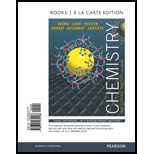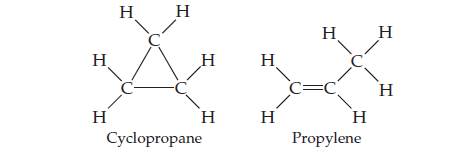
Chemistry: The Central Science, Books a la Carte Plus MasteringChemistry with eText -- Access Card Package (13th Edition)
13th Edition
ISBN: 9780321934826
Author: Theodore E. Brown, H. Eugene LeMay, Bruce E. Bursten, Catherine Murphy, Patrick Woodward, Matthew E. Stoltzfus
Publisher: PEARSON
expand_more
expand_more
format_list_bulleted
Textbook Question
Chapter 19, Problem 48E
Cyclopropane and propylene are isomers that both have the formula C3H6. Based on the molecular structures shown,which of these isomers would you expect to have the higher standard molar entropy at 25 °C?

Expert Solution & Answer
Want to see the full answer?
Check out a sample textbook solution
Students have asked these similar questions
The kinetics of a gas phase reaction of the form A → Products results in a rate constant of 0.00781 M/min. For this reaction, the initial concentration of A is 0.501 M. How many minutes will it take for the concentration of A to reach 0.144 M
What is the rate for the second order reaction A → Products when [A] = 0.256 M? (k = 0.761 M⁻¹s⁻¹)
For reaction N2(g) + O2(g) --> 2NO(g)
Write the rate of the reaction in terms of change of NO.
Chapter 19 Solutions
Chemistry: The Central Science, Books a la Carte Plus MasteringChemistry with eText -- Access Card Package (13th Edition)
Ch. 19.1 - The process of iron being oxidized to make...Ch. 19.1 - Prob. 19.1.2PECh. 19.2 - Do all exothermic phase changes have a negative...Ch. 19.2 - Prob. 19.2.2PECh. 19.3 - Prob. 19.3.1PECh. 19.3 - Prob. 19.3.2PECh. 19.3 - Suppose you have two 1-L flasks, one containing N2...Ch. 19.3 - Prob. 19.4.2PECh. 19.4 -
10.8
Place the following gases in order of...Ch. 19.4 - Prob. 19.5.2PE
Ch. 19.5 - Prob. 19.6.1PECh. 19.5 - Prob. 19.6.2PECh. 19.5 - Prob. 19.7.1PECh. 19.5 - Prob. 19.7.2PECh. 19.5 - Prob. 19.8.1PECh. 19.5 - Prob. 19.8.2PECh. 19.6 - Prob. 19.9.1PECh. 19.6 - Prob. 19.9.2PECh. 19.7 - Prob. 19.10.1PECh. 19.7 - Prob. 19.10.2PECh. 19.7 - Prob. 19.11.1PECh. 19.7 - Prob. 19.11.2PECh. 19.7 - Prob. 19.12.1PECh. 19.7 - Prob. 19.12.2PECh. 19 - Prob. 1DECh. 19 - Prob. 1ECh. 19 - Prob. 2ECh. 19 - Prob. 3ECh. 19 - Prob. 4ECh. 19 - Prob. 5ECh. 19 - Prob. 6ECh. 19 - 11.47 Indicate whether each statement is true or...Ch. 19 - Prob. 8ECh. 19 - Prob. 9ECh. 19 - Prob. 10ECh. 19 - Prob. 11ECh. 19 - Prob. 12ECh. 19 - Prob. 13ECh. 19 - Prob. 14ECh. 19 - A glass vessel fitted with a stopcock valve has a...Ch. 19 - Prob. 16ECh. 19 - Prob. 17ECh. 19 - Prob. 18ECh. 19 - Prob. 19ECh. 19 - Prob. 20ECh. 19 - Prob. 21ECh. 19 - Consider what happens when a sample of the...Ch. 19 - Prob. 23ECh. 19 - Prob. 24ECh. 19 - The normal boiling point of Br2(l) is 58.8 °C, and...Ch. 19 - Prob. 26ECh. 19 - Prob. 27ECh. 19 - Prob. 28ECh. 19 - Prob. 29ECh. 19 - Prob. 30ECh. 19 - Prob. 31ECh. 19 - Prob. 32ECh. 19 - Prob. 33ECh. 19 - Prob. 34ECh. 19 - 19.35 (a) What do you expect for the sign of ∆S in...Ch. 19 - Prob. 36ECh. 19 - Prob. 37ECh. 19 - Prob. 38ECh. 19 - Prob. 39ECh. 19 - Prob. 40ECh. 19 - For each of the fallowing pairs, choose the...Ch. 19 - Prob. 42ECh. 19 - Prob. 43ECh. 19 - Prob. 44ECh. 19 - Prob. 45ECh. 19 - Prob. 46ECh. 19 - Prob. 47ECh. 19 - Cyclopropane and propylene are isomers that both...Ch. 19 - Prob. 49ECh. 19 - Prob. 50ECh. 19 - Prob. 51ECh. 19 - Prob. 52ECh. 19 - Prob. 53ECh. 19 - Prob. 54ECh. 19 - Prob. 55ECh. 19 - Prob. 56ECh. 19 - Prob. 57ECh. 19 - Prob. 58ECh. 19 - Using data in Appendix C, calculate HO, SO,...Ch. 19 - Prob. 60ECh. 19 - Prob. 61ECh. 19 - Prob. 62ECh. 19 - Prob. 63ECh. 19 - Prob. 64ECh. 19 - Prob. 65ECh. 19 - From the values given for H° and S°, calculate G°...Ch. 19 - Prob. 67ECh. 19 - Prob. 68ECh. 19 - Prob. 69ECh. 19 - Prob. 70ECh. 19 - Prob. 71ECh. 19 - Prob. 72ECh. 19 - (a) Use data in Appendix C to estimate the boiling...Ch. 19 - Prob. 74ECh. 19 - Prob. 75ECh. 19 - Prob. 76ECh. 19 - Prob. 77ECh. 19 - Prob. 78ECh. 19 - Consider the reaction 2 NO2(g) (N2O4(g). (a)...Ch. 19 - Prob. 80ECh. 19 - Prob. 81ECh. 19 - Prob. 82ECh. 19 - Prob. 83ECh. 19 - Prob. 84ECh. 19 - Prob. 85ECh. 19 - The Kb, for methylamine (CH3NH2) at 25oC is given...Ch. 19 - Prob. 87AECh. 19 - Prob. 88AECh. 19 - Prob. 89AECh. 19 - Prob. 90AECh. 19 - Prob. 91AECh. 19 - Prob. 92AECh. 19 - Prob. 93AECh. 19 - Prob. 94AECh. 19 - Prob. 95AECh. 19 - Prob. 96AECh. 19 - Consider the following three reactions: (i) Ti (s)...Ch. 19 - Prob. 98AECh. 19 - (a) For each of the following reactions, predict...Ch. 19 - Prob. 100AECh. 19 - Prob. 101AECh. 19 - Prob. 102AECh. 19 - Prob. 103AECh. 19 - Prob. 104AECh. 19 - Prob. 105AECh. 19 - Prob. 106AECh. 19 - Most liquids follow Trouton’s rule (see Exercise...Ch. 19 - 19.108 In chemical kinetics the entropy of...Ch. 19 - Prob. 109IECh. 19 - Prob. 110IECh. 19 - Prob. 111IECh. 19 - Prob. 112IECh. 19 - The following data compare the standard enthalpies...Ch. 19 - Prob. 114IECh. 19 - Prob. 115IECh. 19 - Prob. 116IE
Knowledge Booster
Learn more about
Need a deep-dive on the concept behind this application? Look no further. Learn more about this topic, chemistry and related others by exploring similar questions and additional content below.Similar questions
- What is the name of the major product formed during the reaction between benzoyl chloride and phenol? benzyl ester O phenyl benzoate ○ cyclopentanoate ○ benzyl phenoate ○ benzenecarboxylic acidarrow_forwardProvide the proper IUPAC or common name for the following compound. Dashes, commas, and spaces must be used correctly.arrow_forwardProvide the proper IUPAC name (only) for the following compound. Dashes, commas, and spaces must be used correctly. HO. OHarrow_forward
- Question 2 0/1 pts Provide the proper IUPAC name only for the following compound. Dashes, commas, and spaces must be used correctly. HO CH 3 1-methyl-1-cyclohexanecarboxylic acidarrow_forwardPlease assign all the carbons for C-NMR and hydrogen for H-NMR. Please if I can get that less than hourarrow_forwardAssign these peaks spectrum ( H-NMR and C-NMR)arrow_forward
arrow_back_ios
SEE MORE QUESTIONS
arrow_forward_ios
Recommended textbooks for you
 Chemistry: The Molecular ScienceChemistryISBN:9781285199047Author:John W. Moore, Conrad L. StanitskiPublisher:Cengage Learning
Chemistry: The Molecular ScienceChemistryISBN:9781285199047Author:John W. Moore, Conrad L. StanitskiPublisher:Cengage Learning Principles of Modern ChemistryChemistryISBN:9781305079113Author:David W. Oxtoby, H. Pat Gillis, Laurie J. ButlerPublisher:Cengage Learning
Principles of Modern ChemistryChemistryISBN:9781305079113Author:David W. Oxtoby, H. Pat Gillis, Laurie J. ButlerPublisher:Cengage Learning General Chemistry - Standalone book (MindTap Cour...ChemistryISBN:9781305580343Author:Steven D. Gammon, Ebbing, Darrell Ebbing, Steven D., Darrell; Gammon, Darrell Ebbing; Steven D. Gammon, Darrell D.; Gammon, Ebbing; Steven D. Gammon; DarrellPublisher:Cengage Learning
General Chemistry - Standalone book (MindTap Cour...ChemistryISBN:9781305580343Author:Steven D. Gammon, Ebbing, Darrell Ebbing, Steven D., Darrell; Gammon, Darrell Ebbing; Steven D. Gammon, Darrell D.; Gammon, Ebbing; Steven D. Gammon; DarrellPublisher:Cengage Learning- Chemistry: Matter and ChangeChemistryISBN:9780078746376Author:Dinah Zike, Laurel Dingrando, Nicholas Hainen, Cheryl WistromPublisher:Glencoe/McGraw-Hill School Pub Co
 Introductory Chemistry: A FoundationChemistryISBN:9781337399425Author:Steven S. Zumdahl, Donald J. DeCostePublisher:Cengage Learning
Introductory Chemistry: A FoundationChemistryISBN:9781337399425Author:Steven S. Zumdahl, Donald J. DeCostePublisher:Cengage Learning

Chemistry: The Molecular Science
Chemistry
ISBN:9781285199047
Author:John W. Moore, Conrad L. Stanitski
Publisher:Cengage Learning

Principles of Modern Chemistry
Chemistry
ISBN:9781305079113
Author:David W. Oxtoby, H. Pat Gillis, Laurie J. Butler
Publisher:Cengage Learning

General Chemistry - Standalone book (MindTap Cour...
Chemistry
ISBN:9781305580343
Author:Steven D. Gammon, Ebbing, Darrell Ebbing, Steven D., Darrell; Gammon, Darrell Ebbing; Steven D. Gammon, Darrell D.; Gammon, Ebbing; Steven D. Gammon; Darrell
Publisher:Cengage Learning

Chemistry: Matter and Change
Chemistry
ISBN:9780078746376
Author:Dinah Zike, Laurel Dingrando, Nicholas Hainen, Cheryl Wistrom
Publisher:Glencoe/McGraw-Hill School Pub Co

Introductory Chemistry: A Foundation
Chemistry
ISBN:9781337399425
Author:Steven S. Zumdahl, Donald J. DeCoste
Publisher:Cengage Learning

The Laws of Thermodynamics, Entropy, and Gibbs Free Energy; Author: Professor Dave Explains;https://www.youtube.com/watch?v=8N1BxHgsoOw;License: Standard YouTube License, CC-BY